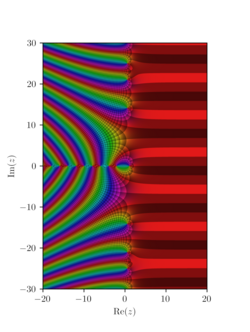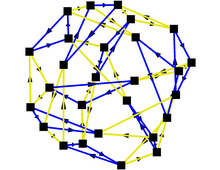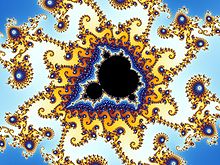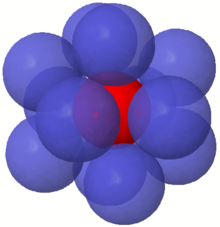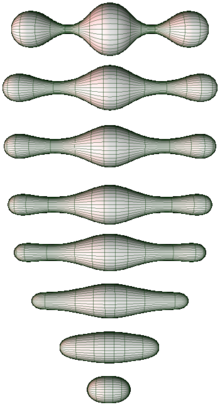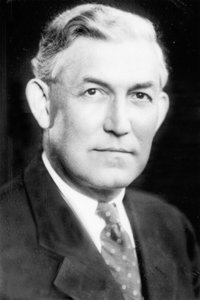
In number theory, a Carmichael number is a composite number which in modular arithmetic satisfies the congruence relation:
A twin prime is a prime number that is either 2 less or 2 more than another prime number—for example, either member of the twin prime pair or (41, 43). In other words, a twin prime is a prime that has a prime gap of two. Sometimes the term twin prime is used for a pair of twin primes; an alternative name for this is prime twin or prime pair.
In combinatorics, Ramsey's theorem, in one of its graph-theoretic forms, states that one will find monochromatic cliques in any edge labelling (with colours) of a sufficiently large complete graph. To demonstrate the theorem for two colours (say, blue and red), let r and s be any two positive integers. Ramsey's theorem states that there exists a least positive integer R(r, s) for which every blue-red edge colouring of the complete graph on R(r, s) vertices contains a blue clique on r vertices or a red clique on s vertices. (Here R(r, s) signifies an integer that depends on both r and s.)
In arithmetic combinatorics, Szemerédi's theorem is a result concerning arithmetic progressions in subsets of the integers. In 1936, Erdős and Turán conjectured that every set of integers A with positive natural density contains a k-term arithmetic progression for every k. Endre Szemerédi proved the conjecture in 1975.

Ben Joseph Green FRS is a British mathematician, specialising in combinatorics and number theory. He is the Waynflete Professor of Pure Mathematics at the University of Oxford.
In mathematics, a covering system is a collection
In mathematics, the Burr–Erdős conjecture was a problem concerning the Ramsey number of sparse graphs. The conjecture is named after Stefan Burr and Paul Erdős, and is one of many conjectures named after Erdős; it states that the Ramsey number of graphs in any sparse family of graphs should grow linearly in the number of vertices of the graph.
In combinatorial number theory, the Erdős–Graham problem is the problem of proving that, if the set of integers greater than one is partitioned into finitely many subsets, then one of the subsets can be used to form an Egyptian fraction representation of unity. That is, for every , and every -coloring of the integers greater than one, there is a finite monochromatic subset of these integers such that
Erdős' conjecture on arithmetic progressions, often referred to as the Erdős–Turán conjecture, is a conjecture in arithmetic combinatorics. It states that if the sum of the reciprocals of the members of a set A of positive integers diverges, then A contains arbitrarily long arithmetic progressions.
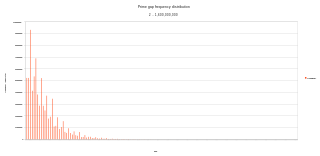
A prime gap is the difference between two successive prime numbers. The n-th prime gap, denoted gn or g(pn) is the difference between the (n + 1)-st and the n-th prime numbers, i.e.

At the 1912 International Congress of Mathematicians, Edmund Landau listed four basic problems about prime numbers. These problems were characterised in his speech as "unattackable at the present state of mathematics" and are now known as Landau's problems. They are as follows:
- Goldbach's conjecture: Can every even integer greater than 2 be written as the sum of two primes?
- Twin prime conjecture: Are there infinitely many primes p such that p + 2 is prime?
- Legendre's conjecture: Does there always exist at least one prime between consecutive perfect squares?
- Are there infinitely many primes p such that p − 1 is a perfect square? In other words: Are there infinitely many primes of the form n2 + 1?
In number theory, the Green–Tao theorem, proved by Ben Green and Terence Tao in 2004, states that the sequence of prime numbers contains arbitrarily long arithmetic progressions. In other words, for every natural number k, there exist arithmetic progressions of primes with k terms. The proof is an extension of Szemerédi's theorem. The problem can be traced back to investigations of Lagrange and Waring from around 1770.
Arithmetic dynamics is a field that amalgamates two areas of mathematics, dynamical systems and number theory. Part of the inspiration comes from complex dynamics, the study of the iteration of self-maps of the complex plane or other complex algebraic varieties. Arithmetic dynamics is the study of the number-theoretic properties of integer, rational, p-adic, or algebraic points under repeated application of a polynomial or rational function. A fundamental goal is to describe arithmetic properties in terms of underlying geometric structures.
In mathematics, arithmetic combinatorics is a field in the intersection of number theory, combinatorics, ergodic theory and harmonic analysis.
In number theory, a Sidon sequence is a sequence of natural numbers in which all pairwise sums (for ) are different. Sidon sequences are also called Sidon sets; they are named after the Hungarian mathematician Simon Sidon, who introduced the concept in his investigations of Fourier series.
In mathematics, the Erdős–Ulam problem asks whether the plane contains a dense set of points whose Euclidean distances are all rational numbers. It is named after Paul Erdős and Stanislaw Ulam.
In geometry, the distance set of a collection of points is the set of distances between distinct pairs of points. Thus, it can be seen as the generalization of a difference set, the set of distances in collections of numbers.

In mathematics, and in particular in arithmetic combinatorics, a Salem-Spencer set is a set of numbers no three of which form an arithmetic progression. Salem–Spencer sets are also called 3-AP-free sequences or progression-free sets. They have also been called non-averaging sets, but this term has also been used to denote a set of integers none of which can be obtained as the average of any subset of the other numbers. Salem-Spencer sets are named after Raphaël Salem and Donald C. Spencer, who showed in 1942 that Salem–Spencer sets can have nearly-linear size. However a later theorem of Klaus Roth shows that the size is always less than linear.
Hunter Snevily (1956–2013) was an American mathematician with expertise and contributions in Set theory, Graph theory, Discrete geometry, and Ramsey theory on the integers.
